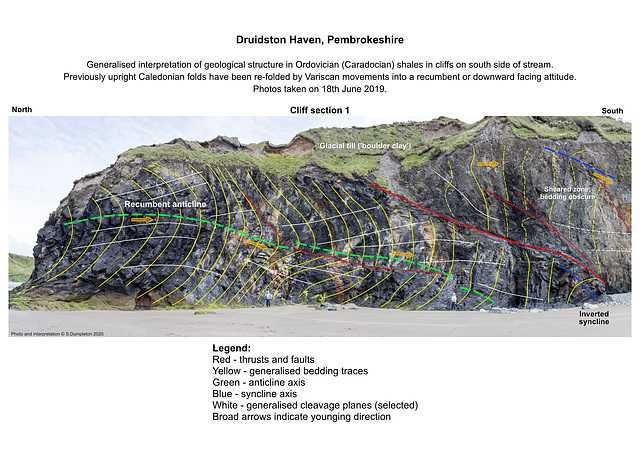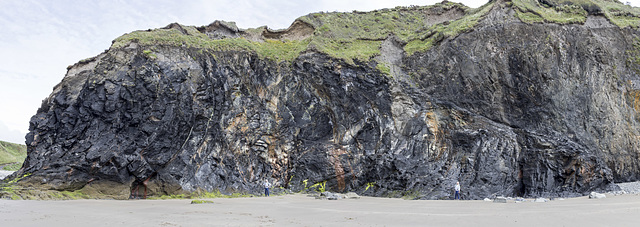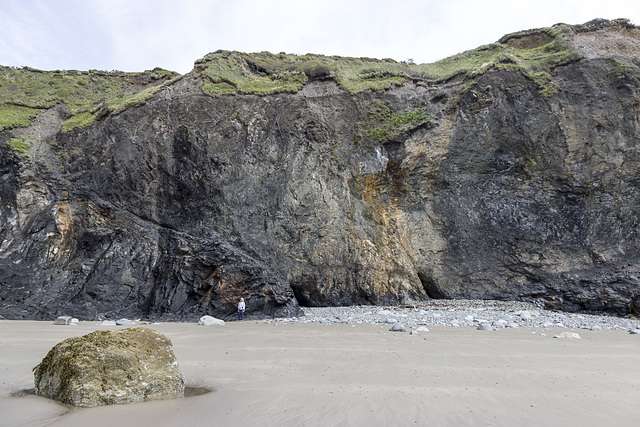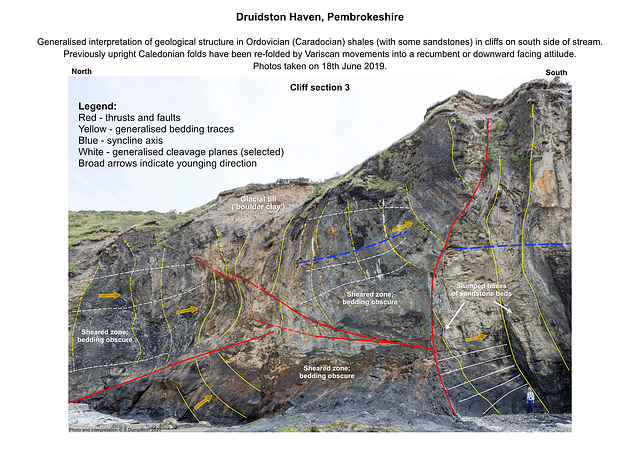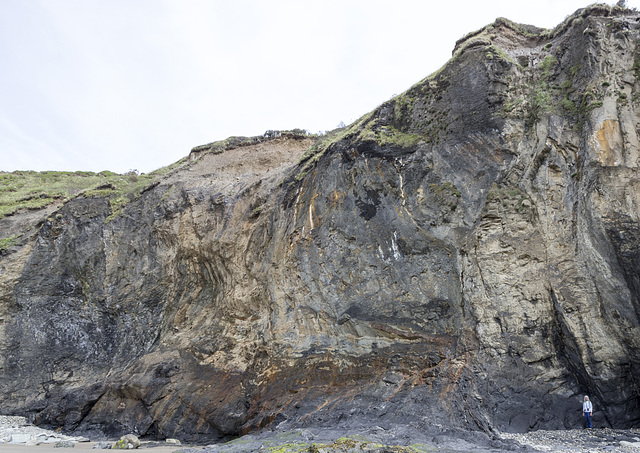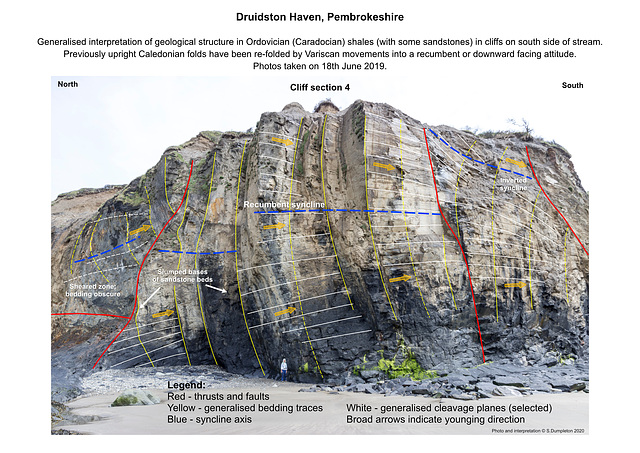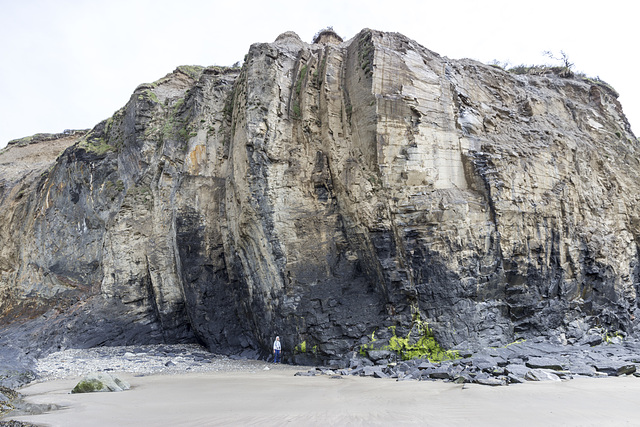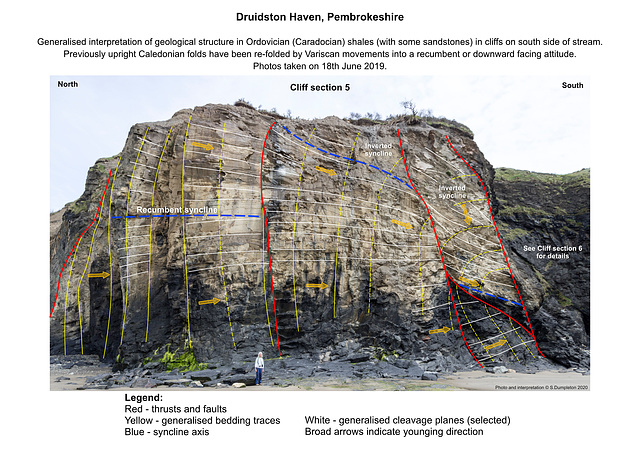
Druidston Haven geological structure
Folder: Geology and Earth Science
A series of six photos and interpretations to illustrate the geology of Druidston Haven, Pembrokeshire.
The cliffs of Druidston Haven mostly consist of Ordovician (Caradocian) age shales with some thin sandstones. During the Caledonian orgogeny at the end of the Silurian period, these were deformed into a series of mostly upright open folds. These were then re-folded by Variscan movements at the …
(read more)
Druidston Haven: Cliff Section 1 interpretation
Druidston Haven geology: Cliff Section 1 interpretation
Interpretation No.1 of a series of six photos and interpretations to illustrate the geology of Druidston Haven, Pembrokeshire. Photo No.1 of a series of six photos and interpretations to illustrate the geology of Druidston Haven, Pembrokeshire. The background is a panoramic view of two photos stitched together using Photoshop software.
The cliffs of Druidston Haven mostly consist of Ordovician (Caradocian) age shales with some thin sandstones. During the Caledonian orgogeny at the end of the Silurian period, these were deformed into a series of mostly upright open folds. These were then re-folded by Variscan movements at the end of Carboniferous, to become largely recumbent (near horizontal) or partly inverted, facing down towards the south.
The Ordovician rocks form a horst - a ridge or block of strata faulted against younger rocks on either side. The Druidston Horst is bounded by the South Druidston Boundary Fault at the south end of the Haven, and the North Druidston Boundary Fault at the north end. These photos show the section midway along the horst from the stream to the Southern Boundary Fault at the far end.
Druidston Haven: Cliff Section 1 panorama
Druidston Haven geology: Cliff Section 1
Photo No.1 of a series of six photos and interpretations to illustrate the geology of Druidston Haven, Pembrokeshire. This is a panoramic view of two photos stitched together using Photoshop software.
The cliffs of Druidston Haven mostly consist of Ordovician (Caradocian) age shales with some thin sandstones. During the Caledonian orgogeny at the end of the Silurian period, these were deformed into a series of mostly upright open folds. These were then re-folded by Variscan movements at the end of Carboniferous, to become largely recumbent (near horizontal) or partly inverted, facing down towards the south.
The Ordovician rocks form a horst - a ridge or block of strata faulted against younger rocks on either side. The Druidston Horst is bounded by the South Druidston Boundary Fault at the south end of the Haven, and the North Druidston Boundary Fault at the north end. These photos show the section midway along the horst from the stream to the Southern Boundary Fault at the far end.
Druidston Haven: Cliff Section 2 interpretation
Druidston Haven geology: Cliff Section 2 interpretation
Interpretation No.2 of a series of six photos and interpretations to illustrate the geology of Druidston Haven, Pembrokeshire.
The cliffs of Druidston Haven mostly consist of Ordovician (Caradocian) age shales with some thin sandstones. During the Caledonian orgogeny at the end of the Silurian period, these were deformed into a series of mostly upright open folds. These were then re-folded by Variscan movements at the end of Carboniferous, to become largely recumbent (near horizontal) or partly inverted, facing down towards the south.
The Ordovician rocks form a horst - a ridge or block of strata faulted against younger rocks on either side. The Druidston Horst is bounded by the South Druidston Boundary Fault at the south end of the Haven, and the North Druidston Boundary Fault at the north end. These photos show the section midway along the horst from the stream to the Southern Boundary Fault at the far end.
Druidston Haven: Cliff Section 2
Druidston Haven geology: Cliff Section 2
Photo No.2 of a series of six photos and interpretations to illustrate the geology of Druidston Haven, Pembrokeshire.
The cliffs of Druidston Haven mostly consist of Ordovician (Caradocian) age shales with some thin sandstones. During the Caledonian orgogeny at the end of the Silurian period, these were deformed into a series of mostly upright open folds. These were then re-folded by Variscan movements at the end of Carboniferous, to become largely recumbent (near horizontal) or partly inverted, facing down towards the south.
The Ordovician rocks form a horst - a ridge or block of strata faulted against younger rocks on either side. The Druidston Horst is bounded by the South Druidston Boundary Fault at the south end of the Haven, and the North Druidston Boundary Fault at the north end. These photos show the section midway along the horst from the stream to the Southern Boundary Fault at the far end.
Druidston Haven: Cliff Section 3 interpretation
Druidston Haven geology: Cliff Section 3 interpretation
Interpretation No.3 of a series of six photos and interpretations to illustrate the geology of Druidston Haven, Pembrokeshire.
The cliffs of Druidston Haven mostly consist of Ordovician (Caradocian) age shales with some thin sandstones. During the Caledonian orgogeny at the end of the Silurian period, these were deformed into a series of mostly upright open folds. These were then re-folded by Variscan movements at the end of Carboniferous, to become largely recumbent (near horizontal) or partly inverted, facing down towards the south. The sandstone beds seen in this photo show irregular slumped bases and load casts, thus confirming that these beds young to the south (right).
The Ordovician rocks form a horst - a ridge or block of strata faulted against younger rocks on either side. The Druidston Horst is bounded by the South Druidston Boundary Fault at the south end of the Haven, and the North Druidston Boundary Fault at the north end. These photos show the section midway along the horst from the stream to the Southern Boundary Fault at the far end.
Druidston Haven: Cliff Section 3
Druidston Haven geology: Cliff Section 3
Photo No.3 of a series of six photos and interpretations to illustrate the geology of Druidston Haven, Pembrokeshire.
The cliffs of Druidston Haven mostly consist of Ordovician (Caradocian) age shales with some thin sandstones. During the Caledonian orgogeny at the end of the Silurian period, these were deformed into a series of mostly upright open folds. These were then re-folded by Variscan movements at the end of Carboniferous, to become largely recumbent (near horizontal) or partly inverted, facing down towards the south. The sandstone beds seen in this photo show irregular slumped bases and load casts, thus confirming that these beds young to the south (right).
The Ordovician rocks form a horst - a ridge or block of strata faulted against younger rocks on either side. The Druidston Horst is bounded by the South Druidston Boundary Fault at the south end of the Haven, and the North Druidston Boundary Fault at the north end. These photos show the section midway along the horst from the stream to the Southern Boundary Fault at the far end.
Druidston Haven: Cliff Section 4 interpretation
Druidston Haven geology: Cliff Section 4 interpretation
Interpretation No.4 of a series of six photos and interpretations to illustrate the geology of Druidston Haven, Pembrokeshire.
The cliffs of Druidston Haven mostly consist of Ordovician (Caradocian) age shales with some thin sandstones. During the Caledonian orgogeny at the end of the Silurian period, these were deformed into a series of mostly upright open folds. These were then re-folded by Variscan movements at the end of Carboniferous, to become largely recumbent (near horizontal) or partly inverted, facing down towards the south. The sandstone beds seen in this photo show irregular slumped bases and load casts, thus confirming that these beds young to the south (right).
The Ordovician rocks form a horst - a ridge or block of strata faulted against younger rocks on either side. The Druidston Horst is bounded by the South Druidston Boundary Fault at the south end of the Haven, and the North Druidston Boundary Fault at the north end. These photos show the section midway along the horst from the stream to the Southern Boundary Fault at the far end.
Druidston Haven: Cliff Section 4
Druidston Haven geology: Cliff Section 4
Photo No.4 of a series of six photos and interpretations to illustrate the geology of Druidston Haven, Pembrokeshire.
The cliffs of Druidston Haven mostly consist of Ordovician (Caradocian) age shales with some thin sandstones. During the Caledonian orgogeny at the end of the Silurian period, these were deformed into a series of mostly upright open folds. These were then re-folded by Variscan movements at the end of Carboniferous, to become largely recumbent (near horizontal) or partly inverted, facing down towards the south. The sandstone beds seen in this photo show irregular slumped bases and load casts, thus confirming that these beds young to the south (right).
The Ordovician rocks form a horst - a ridge or block of strata faulted against younger rocks on either side. The Druidston Horst is bounded by the South Druidston Boundary Fault at the south end of the Haven, and the North Druidston Boundary Fault at the north end. These photos show the section midway along the horst from the stream to the Southern Boundary Fault at the far end.
Druidston Haven: Cliff Section 5 interpretation
Druidston Haven geology: Cliff Section 5 interpretation
Interpretation No.5 of a series of six photos and interpretations to illustrate the geology of Druidston Haven, Pembrokeshire.
The cliffs of Druidston Haven mostly consist of Ordovician (Caradocian) age shales with some thin sandstones. During the Caledonian orgogeny at the end of the Silurian period, these were deformed into a series of mostly upright open folds. These were then re-folded by Variscan movements at the end of Carboniferous, to become largely recumbent (near horizontal) or partly inverted, facing down towards the south.
The Ordovician rocks form a horst - a ridge or block of strata faulted against younger rocks on either side. The Druidston Horst is bounded by the South Druidston Boundary Fault at the south end of the Haven, and the North Druidston Boundary Fault at the north end. These photos show the section midway along the horst from the stream to the Southern Boundary Fault at the far end.
Jump to top
RSS feed- Latest items - Subscribe to the latest items added to this album
- ipernity © 2007-2024
- Help & Contact
|
Club news
|
About ipernity
|
History |
ipernity Club & Prices |
Guide of good conduct
Donate | Group guidelines | Privacy policy | Terms of use | Statutes | In memoria -
Facebook
Twitter

